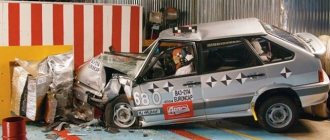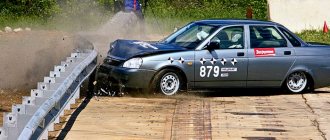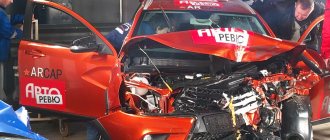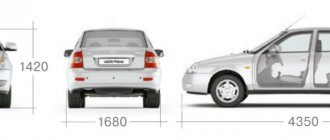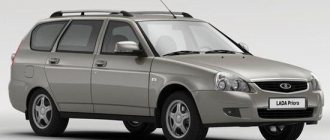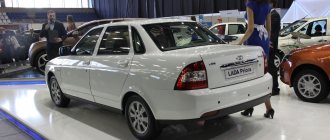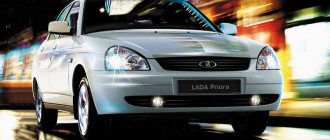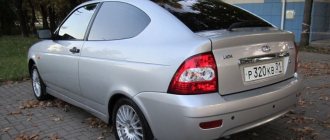Our unique double crash test with unbelted dummies proved that wearing a seat belt triples your chances of survival in a frontal crash at 50 km/h! What happens in a side impact? Maybe having a seat belt fastened is not so important in a side collision?
We decided to answer this question experimentally. And again we turned to the AvtoVAZ shock testing laboratory.
Among supporters of freedom from seat belts, there is an opinion that in the event of a side impact, belted riders are no more protected than unbelted ones. They say, anyway, the distance from the crushed door to the person is so small that the straps do not have time to work - a strong blow to the upholstery is inevitable. And the diagonal strap of the belt can even break a person’s neck. In addition, an unbelted rider who is hit from the side can simply fly off in the other direction, while a person pinned by a belt in the same situation will find himself in a crushing trap and will inevitably die. And the belt lock can become tightly jammed between the chair and the armrest box - and then you won’t be able to “unfasten” without a knife.
Myths, myths...
Meanwhile, according to American statistics, side accidents account for approximately 40% of the total. In Russia, on average there are one and a half casualties for every side collision, and 1.05 for every frontal collision. They are almost one and a half times more dangerous than frontal impacts! After all, if in front of almost any car there is a “life meter” in the form of deformable body structures, then in a side collision the people in the cabin are separated from the ram striking on the left or right: a door, a threshold, a B pillar... All this is literally a few centimeters from you! Any significant deformation and serious injuries cannot be avoided. Therefore, designers reinforce the doors with safety bars; the sills and body pillars are made of high-strength steel. And the role of the main restraint system, securing passengers in place, is still performed by belts, which are assisted by side airbags.
Side airbags for domestic cars are a luxury that is still unthinkable. Even the new Lada Priora sedans (VAZ-2170), which the VAZ team and I decided to smash during the experiment, do not have them. Only belts.
So let's use them!
Or rather, dummies will use belts: during the first side impact in the Priora, we will seat four fastened “riders”. And we will carry out the second blow by unfastening the seat belts. And compare the loads on the mannequins. After all, the conditions of both crash tests are exactly the same: a brand new Priora with four dummies in the cabin is hit in the middle pillar on the driver’s side by a trolley weighing 950 kg, moving at a speed of 50 km/h. This is the side crash test required by UNECE Regulation No. 95-01 for all vehicles sold in Europe, and the same methodology is used by the Euro NCAP program.
By the way, special “side” SID dummies (in Europe - EuroSID) “work” in side crash tests. But since the VAZ has only two “side” EuroSID I dummies, we will put them in the two leftmost seats - front and rear. And the right seats will be occupied by regular Hybrid III mannequins. Although they are not intended for side crash tests, they will be able to give us reliable information about the loads on the neck and head: the hinges of their “necks” are anthropomorphic when nodding right and left, and sensors record information about overloads in all three directions.
All the “special preparation” of the cars consisted of dismantling the bumpers, headlights, hood and trunk lid: it was necessary to rigidly attach high-speed cameras to powerful brackets, recording what was happening in the cabin. This had no effect on the rigidity of the body during a side impact. But you can’t remove glued glass to avoid glare - they “hold” the openings.
And so the first Priora with its seat belts fastened froze in its original position: if the car itself accelerates during a frontal crash test, then it plays the role of a stationary target, and a cart with a deformable barrier attached to it “shoots” from the accelerating catapult. Moreover, the cart is aimed at Priora so that the axis of impact falls on the tailbone of the driver’s dummy.
Will the poor guy get it?
We retreat to a safe distance. Acceleration of the cart... Bang-bang!
The black marks on the floor show that the cart threw Priora five meters. But the strong body and powerful bars in the doors protected the riders. Buckled up...
The Priora, accompanied by the squeal of rubber and the furious roar of crushed metal, is slightly turned around the center of mass, located at the front axle, and thrown five meters from its original position. But the car clearly withstood the impact: the side panel was dented by no more than 30 cm, and the door locks did not open. VAZ, by the way, had no doubts about Priora at all: they claim that the updated sedan with safety bars in the doors and a stronger body than the “ten” in a side crash test using the Euro NCAP method (with one driver dummy) scores 11— 13 points out of 16 possible.
Looks like it's true.
Open the right doors. The dummies are sitting in their seats as if nothing had happened, only the front “passenger” has jumped out from under the diagonal strap. The buckles of all four belts can be easily unfastened, despite the fact that the driver's seat is pinched by a deformed seat.
Front occupants buckled up moments before impact. 42 milliseconds after touching the cart, the “driver” harmlessly touched the pillar pad (HIC - 248), and the “passenger” began to slip out from under the belt. 82 ms have passed. A fatal set of circumstances for the front “passenger”: he leans to the left and his neck breaks on the “shoulder of friendship” of the “driver”. Upon completion of the active phase of the impact, the “passenger” tries to dive back under the safety belt
Only high-speed cameras and overload graphs will tell us what happened during the impact. First, almost simultaneously, the driver and rear left passenger (at the 52nd millisecond) touched their heads to the body pillars. But the blows were not dangerous: the maximum 67 g and 46 g of average overload in three milliseconds do not even threaten a concussion. Unfortunately, the driver's chest and pelvis are not so well protected. The compressive loads on the upper of the three “ribs” approached the border of the dangerous “red” zone (39 mm of deformation at a threshold of 42 mm). The EuroSID I dummy also has a sensor in the so-called pubic joint - between the legs, so to speak. The load on it determines the risk of injury to the pelvic area. And the driver’s sensor was compressed decently: with a force of 5.1 kilonewtons. That's half a ton! Very close to the dangerous threshold of 6.0 kN.
But the total loads on the “driver’s” abdominal cavity only slightly exceeded the safe 100 kilogram-force (1 kN). As a result, the protection of a belted driver in the Priora, with nine points out of 16 possible, can be assessed as average. Lower than the 11-13 points promised by VAZ, but this was probably due to the greater load of the car: the exchange of kinetic energy with a one-ton cart proceeded differently than in a regular side crash test, which could affect the “injuries” of the “driver” .
In any case, none of the parameters of the fastened driver dummy exceeded critical values - there is no danger to life. The rear left passenger who uses the seat belt is in no danger at all: all loads are below the border of the “green” zone.
Rear seatbelt dummies before impact. 52 ms. The left “passenger” rested his head against the pillar (HIC - 106). The right “passenger” is held by the lap belt strap, and the body only tilts and does not slide towards the neighbor. 120 ms. Headbutting a neighbor's shoulder is not dangerous (HIC - 512). There is no secondary impact on the rebound - the straps hold the dummies
What about the passengers on the right? Everything would be fine with them, if not for one thing - the sensors of the front right rider recorded an excess of the bending moment of the neck: 79.1 Nm with a threshold of 57 Nm! Did what the opponents of seat belts talk about actually happen—the diagonal strap “broke” the right passenger’s neck?
Nothing like this. The tragedy occurred due to the fact that after the impact, the passenger dummy shifted to the left, and the “driver” at that moment exposed him to the stump of his right hand. Carefully to the base of the skull! So the “neck” bent...
So, the belts allowed three out of four riders to escape without serious injury, not to mention a threat to life. What will happen without belts?
What happened?
Crash test with unbelted passengers, front view a fraction of a second before the side ram. 42 ms. The "driver" is hit by the door, deformed by the trolley - it hits him much harder than with a belt. And the “passenger”, in the absence of a belt, slides his whole body to the side by inertia. 110 ms. The “passenger” breaks his neck, resting his shoulder against the “driver’s” shoulder and inflicting a sensitive (but not fatal) head blow on him. It's all over: the "passenger" falls face down into the "driver's" lap with an injury to the "cervical vertebrae"
Until the fiftieth millisecond, everything was the same as during the first impact: the “driver” and the rear left “passenger” were hitting the crumpling doors and body pillars. But with a significant difference: the belts do not hold them. Therefore, the loads on the “chest” and “stomach” of the “driver” are much higher: 56 mm of deformation of the calibrated ribs of the mannequin with a dangerous limit of 42 mm are guaranteed fractures for a person!
The mark from the ribs of the unfastened dummy is exactly on the inactive belt...
But the worst thing happens later, when 106-120 milliseconds after the start of the impact, the unbelted neighbors reach those sitting on the left.
This is a fight without rules. A head-to-head blow, even on fighting grounds, is considered one of the most dangerous, but here... The one sitting behind the driver was again unlucky: a powerful right hook delivered by his neighbor’s head left him no chance. A peak overload of 350 g and a head injury probability coefficient HIC of 2110 units are a record in the entire history of Autoreview crash tests!
It's like being hit in the face with a lead bat. It is no easier for the one who dealt the fatal blow: the peak overload for the rear right rider was 230 g, and the HIC coefficient reached 1024 units, exceeding the “red” threshold of 1000.
Behind are two corpses. But if they buckle up...
Unbelted rear passengers, rear view. 84 ms. The right passenger begins his flight, and the unfastened “driver” presses the brake pedal (the brake light comes on). The tragic ending is at 118 milliseconds: a terrible head-to-head blow kills both rear riders. Lifeless bodies also touch their heads during the “rebound”...
What's going on in front? The impact of the head of the front “passenger” in the “face” of the “driver” is not so terrible - “only” 115 g at the peak, the average deceleration over three milliseconds is 49 g, and the HIC did not exceed 145 units. But the right front “passenger”, when hit shoulder to shoulder with the “driver”, receives monstrous loads on the “neck” - 105 Nm, twice the dangerous limit of 57 Nm. Guaranteed break!
It turns out that the driver is the only one of all the unbelted passengers who can survive. Albeit with broken ribs, a broken spleen and a concussion.
So, the score is 3:1 in favor of the belts. Judging by the sensor readings, if among those who were wearing a seat belt only the front “passenger” “died”, then among those who were not seat belted only the “driver” “survived”. And this is at a relatively low speed of 50 km/h. But worse accidents happen in life...
By the way, as in the case of the first experiment with unfastened dummies, the most dangerous place in a left-side impact turned out to be the rear left. After all, the risk of a fatal traumatic brain injury for a belted rear left passenger is ten times lower compared to an unbelted one! Compare this with “only” a threefold difference in loads in a frontal impact, and you will understand that seat belts are even more important during a side collision with your car than in a frontal collision. And the importance of belts for rear passengers is no less important than for the driver and front passenger. Judging by our data, it is even higher!
| Some test results of VAZ-21703 cars using the EuroNCAP method (UNECE regulation No. 95-01) | ||||||||||
| Measurement parameters | Tests Autoreview | EuroNCAP standards | ||||||||
| driver dummy | front passenger dummy | rear left passenger dummy | rear right passenger dummy | border of the "green" zone | border of the “red” zone | |||||
| Using seat belts | buckled up | not wearing a seat belt | buckled up | not wearing a seat belt | buckled up | not wearing a seat belt | buckled up | not wearing a seat belt | ||
| Maximum head overload*, g | 67 | 85 | 34 | 49,5 | 46 | 68,6 | 47,1 | 62,2 | 72 | 88 |
| HIC | 248 | 372 | 86 | 145 | 106 | 2110 | 512 | 1024 | 650 | 1000 |
| Neck bending moment, Nm | n.d.** | n.d. | 79,1 | 104,6 | n.d. | n.d. | 15,7 | 98,3 | 42 | 57 |
| Upper rib deformation, mm | 39 | 56 | n.d. | n.d. | 18 | 16 | n.d. | n.d. | 22 | 42 |
| Middle rib deformation, mm | 31 | 42 | n.d. | n.d. | 3 | 3 | n.d. | n.d. | 22 | 42 |
| Deformation of the lower rib, mm | 23 | 34 | n.d. | n.d. | 0 | 0 | n.d. | n.d. | 22 | 42 |
| Total load on the abdominal cavity, kN | 1,3 | 1,6 | n.d. | n.d. | 0,73 | 1,14 | n.d. | n.d. | 1 | 2,5 |
| Force at the pubic joint, kN | 5,1 | 4,59 | n.d. | n.d. | n.d. | n.d. | n.d. | n.d. | 3 | 6 |
| * Within three milliseconds ** N.A. - no data | ||||||||||
***
And the main conclusion from all our experiments is this: an unbelted person in a car is a potential criminal. He poses a danger not only to himself, but also to belted passengers who risk getting into the same car with him. You can list the inconveniences of belts as much as you like, but they are worth absolutely nothing compared to the main thing - human life, which in most cases belts help save. Therefore, every time you get into a car, do not be lazy and act like a flight attendant, politely but persistently demanding that you fasten your seat belt.
Lada Priora 2022 (new model): photo Lada
AvtoVAZ decided to update a relatively old, but still popular model, making it more comfortable, while at the same time affordable compared to its more expensive models. The appearance remained recognizable and did not change much, but the following can be highlighted:
- The appearance of the car will remain generally familiar. The main distinguishing features will be the appearance of new options and additions that were not previously installed on Priora.
- The front part of the car has been slightly changed, the radiator grille has been replaced, now it has a new shape and looks more stylish. Its area has increased, its width has become larger.
- Special holes appeared on the hood, which are needed to prevent the engine from overheating during intensive operation.
- The shape of the fog lights has noticeably changed and the light has improved. The headlight surrounds are decorated with a chrome line, making the car look more attractive; added shine.
- If you look at the new Priora from the rear, you will notice changes only in the lights, they have received LEDs, but in general the design has not changed, and the car looks familiar.
- The shape of the roof has changed, now it looks more like a dome.
- In addition, the angle of the rear glass has become greater.
- If you look at the car from the side, you will notice similar features to the Lada Vesta, as X-shaped elements have appeared.
- Folding mirrors with turn signal indicators were added.
Interior design
As for the interior, restyling did not make a revolution, and in general the new Priora is not much different from the usual one, but there are still some features:
- The dashboard has become more informative, new elements have been added. Higher quality plastic was used, the design of the board itself was changed, it began to look much more attractive than before.
- If you purchase the maximum configuration, all the control buttons will be in place, however, when using the basic version of the car, there will be a lot of plugs on the dashboard, not everyone will like to see them, however, the panel itself is standard, so if desired, the purchased Priora can then be supplemented with the necessary equipment, and the buttons will be where to put.
- The seats have not become wider, so if you have a large build, it may not be very comfortable to sit. The front seats have several settings and are manually adjustable.
- The quality of the upholstery has improved, but the fabric used is rather rough. This is done in order to increase its wear resistance without increasing the price of the car.
- The build quality is unlikely to please you; don’t be afraid of extraneous creaks or large uneven gaps. The plastic does not fit tightly everywhere and can creak in places. All parts are plastic, no aluminum or wood inserts are provided even in the standard configuration.
- The rear seats cannot be adjusted; it is worth noting that there is quite a bit of space in the back, and it is not very comfortable to sit if you are tall.
- But the sound insulation of the car has become much better; the engine and tire noise are almost inaudible.
New Lada Priora 2022: photos, prices, specifications
The car's engines have not undergone any evolution in terms of parameters. The buyer still has a standard choice:
- Petrol engine with a volume of 1.6 liters and a power of 106 hp.
- The 1.8-liter engine is also gasoline, but more powerful – 123 hp.
- It is planned to significantly change the car’s suspension; it will become more comfortable and reliable; perhaps the ground clearance will increase, since the Priora is primarily designed for use on Russian roads, the quality of which leaves much to be desired, but so far the manufacturer has not provided clear data on the suspension.
Inexpensive sedan LADA Priora
At the end of September 2013, at the Tolyatti Motor Expo Motor Show, AvtoVAZ presented an updated version of the flagship Lada Priora model, which received minor external adjustments and a completely new interior. This is the form in which the car is currently being produced, but it’s not a bad idea to remember how its life cycle went. Production of the Priora sedan began in March 2007, and a month later it went on sale.
The model received its first modernization in 2011: it received a new front bumper and rear-view mirrors, a new steering wheel was installed in the cabin, and the list of equipment was expanded with previously unavailable functions. In addition, the car in the “Standard” configuration began to use an 8-valve engine with a lightweight connecting rod and piston group.
In September 2013, Lada Priora was updated again, but this time the changes were much more significant. If the exterior was only slightly adjusted (daytime running lights were added to the head optics, LED lights were installed at the rear), then the interior acquired a completely new design, seats with a modified configuration and other finishing materials. Modernization also affected technology, in particular, the driving performance of the Priora was improved, sound insulation was improved, and an exchange rate stability system (ESC) appeared.
The three-volume Lada Priora looks quite modern by today's standards, although the “tenth” heredity can be seen immediately, especially in profile. The front part of the VAZ sedan is distinguished by teardrop-shaped optics (unfortunately, not lensed) with daytime running lights, a pentagonal radiator grille with honeycomb-shaped cells and a chrome frame, as well as a moderately embossed bumper with an air intake “mouth” and fog lights spaced on the sides ( in expensive versions).
The silhouette of the Priora is devoid of any hint of dynamism, but at the same time it looks good due to the sloping hood, almost flat roof line and trunk protruding back. The stern with a simple design does not shine with design delights, and the only things that can be noted on it are the lights with LED sections for side lights and brake lights, as well as a neat bumper with a plastic insert at the bottom.
The Lada Priora sedan is a typical representative of the B-class according to the European classification: 4350 mm in length, 1420 mm in height and 1680 mm in width. The modest wheelbase of 2492 mm affects the amount of internal space, but the ground clearance is well adapted to Russian realities - 165 mm.
The interior of the three-box model looks modern and attractive, although the level of assembly and quality of materials are still low. A massive steering wheel with a 3-spoke design is topped with the brand’s signature emblem, and behind it is a dashboard with two shallow “wells” and a monochrome trip computer display between them: visually beautiful, but readability is not ideal.
The center console focuses on a 7-inch multimedia display with touch controls. Below it there is a place for rectangular ventilation deflectors and a neat “music” control unit, and even lower is the “climate” control panel, represented by three “knobs”.
The interior space of the three-volume Lada Priora is “woven” from inexpensive, mostly hard plastics. The center console shines in black lacquer, and the seats are cloth upholstered. Everything is assembled quite well, but there are pronounced joints between some panels.
The wide front seats of the Priora with a cushion of optimal length are practically devoid of lateral support, and they are only adjustable longitudinally over fairly wide ranges. The rear sofa is designed for two people, and the fact that a third will be superfluous is clearly hinted at by the protruding transmission tunnel and a pair of headrests. While there is enough space in width and overhead even for tall passengers, the legs are downright cramped. The only convenience is the center armrest.
The Russian sedan has a spacious luggage compartment with a volume of 430 liters, but it cannot be increased - the central section folds down to transport long items, and the back itself does not fold. Under the raised floor there is a full-size spare wheel, but the wheel arch add-ons and the uncovered trunk lid hinges somewhat limit the possibilities for transporting cargo.
Specifications. The Lada Priora is equipped with two petrol engines and two types of gearboxes in a three-volume solution. The “junior” representative of the power line is the VAZ-21126 in-line 1.6-liter “four” with a 16-valve DOHC timing system and distributed fuel injection technology, generating a maximum of 98 horsepower at 5600 rpm and 145 Nm of torque at 4000 rpm In combination with a 5-speed manual transmission with cable drive, the naturally aspirated sedan propels the sedan to the first hundred in 11.5 seconds and provides a possible speed of 183 km/h.
The “top” option is a four-cylinder VAZ-21127 engine with a volume of 1.6 liters (1596 cubic centimeters) with a modified fuel injection system and dynamic supercharging, the output of which is 106 “horses” at 5800 rpm, and a peak thrust of 148 Nm occurs at 4200 rpm It comes in tandem with a manual transmission and a 5-speed robot with a manual gear change function. In the first case, the three-volume engine accelerates to 100 km/h in 11.5 seconds, in the second – in 12.6 seconds (in manual mode – 1.2 seconds faster), and its top speed will not exceed 183 km/h.
Standard
This is the basic package, the cost of which will be 387,000 rubles. It will include:
- One airbag provided for the driver's seat.
- ISOFIX child seat mounting system.
- ABS, EBD, BAS.
- Headrests.
- Signaling.
- Electric power steering.
- There will be no radio, only audio preparation.
- Front windows.
- Exterior mirrors will be heated and electrically driven.
- The seats are heated.
- Climate control can be installed for an additional fee.
- Discs are installed either R 13 or R 14.
- The Special Edition interior is available for an extra charge.
Rear bumper skirt SE "Fortuna" part 6 — Lada Priora Hatchback, 1.6 l., 2008 on DRIVE2
The skirt for my bumper is ready. Yesterday I picked up the skirt and rear bumper from painting. The thresholds for my Priora have been lying around for 2 weeks now. The skirt consists of 4 parts: a central diffuser, side trims (left and right) and a skirt reinforcement - it also attaches it to the bumper and reduces windage.
painted 4 parts
internal
Now all that remains is to install it all. Maybe tomorrow August 25th I will do it. today, no way. The skirt still doesn’t have a brake light and is only for the Hatchback, but it met the target cost of 2000 -2500 with painting. I purchased a new type of bumper amplifier - polystyrene foam for 700 rubles.
I will immediately install diode reflectors ladaprioratuning.ru/Razny…tafoty-dlya-Lada-Priora-2. I will not install LED lights.
The skirt can be ordered here ladaprioratuning.ru/Vnesh…adnego-bampera-SE-FortunaThe first five who ordered from Drive2 get free painting (600 rubles) in exchange for a photo 
I don’t have any photos yet, I’ll post some drawings
back view
side view
Price: 2,400 ₽ Mileage: 130,000 km
Norma
A richer version, such a car will cost 417 thousand and include the following:
- Engine 1.6 liters with a power of 106 hp.
- Five-speed manual transmission.
- The driver will be protected by one airbag.
- The rear seats will have two headrests.
- The rear row has an ISOFIX system for installing child seats.
- The car already has an immobilizer installed.
- A modern alarm system is provided.
- Running lights for daytime use.
- ABS, BAS, EBD.
- The engine is protected from below by a solid steel sheet.
- The instrument panel includes an on-board computer.
- There is an armrest for rear passengers, and between the front seats there is a container for storing small items.
- The rear seats can be folded down.
- The passenger visor has a mirror.
- There is a 12 V socket in the cabin.
- There is a case for storing glasses for the driver.
- The steering rack and seat belts are adjustable, and power steering is installed.
- The windows are tinted from the factory.
- Central locking is installed, which can be controlled from the alarm key fob.
- Audio preparation is provided.
- The side mirrors are electrically heated.
- The front door windows are raised by electric windows.
- The wheels are size R14, steel sheets, decorated with caps.
- All door handles will be painted to match the body color.
Lada Priora 2013 - 2022 / Lada Priora - Photo, video and colors - Auto-Offer.ru
Lada Priora 2013 sedan main view Lada Priora 2013 sedan main view
Lada Priora 2013 hatchback 5-door main view Lada Priora 2013 hatchback 5-door main view
Lada Priora 2013 station wagon main view Lada Priora 2013 station wagon main view
Lada Priora 2013 sedan general view Lada Priora 2013 sedan general view
Lada Priora 2013 sedan rear view Lada Priora 2013 sedan rear view
Lada Priora 2013 sedan side view Lada Priora 2013 sedan side view
Lada Priora 2013 sedan headlights Lada Priora 2013 sedan headlights
Lada Priora 2013 sedan gearbox Lada Priora 2013 sedan gearbox
Lada Priora 2013 sedan front view Lada Priora 2013 sedan front view
Lada Priora 2013 sedan rear lights Lada Priora 2013 sedan rear lights
Lada Priora 2013 sedan wheels Lada Priora 2013 sedan wheels
Lada Priora 2013 sedan interior 2 Lada Priora 2013 sedan interior 2
Lada Priora 2013 sedan steering wheel Lada Priora 2013 sedan steering wheel
Lada Priora 2013 sedan interior 1 Lada Priora 2013 sedan interior 1
Lada Priora 2013 sedan doors Lada Priora 2013 sedan doors
Lada Priora 2013 sedan view from the driver's side Lada Priora 2013 sedan view from the driver's side
Lada Priora 2013 sedan dashboard Lada Priora 2013 sedan dashboard
Lada Priora 2013 station wagon general view Lada Priora 2013 station wagon general view
Lada Priora 2013 station wagon rear view Lada Priora 2013 station wagon rear view
Lada Priora 2013 station wagon side view Lada Priora 2013 station wagon side view
Lada Priora 2013 station wagon dashboard Lada Priora 2013 station wagon dashboard
Lada Priora 2013 station wagon headlights Lada Priora 2013 station wagon headlights
Lada Priora 2013 station wagon gearbox Lada Priora 2013 station wagon gearbox
Lada Priora 2013 station wagon front view Lada Priora 2013 station wagon front view
Lada Priora 2013 station wagon interior 2 Lada Priora 2013 station wagon interior 2
Lada Priora 2013 station wagon steering wheel Lada Priora 2013 station wagon steering wheel
Lada Priora 2013 station wagon interior 1 Lada Priora 2013 station wagon interior 1
Lada Priora 2013 station wagon doors Lada Priora 2013 station wagon doors
Lada Priora 2013 station wagon view from the driver's side Lada Priora 2013 station wagon view from the driver's side
Lada Priora 2013 hatchback 5-door general view Lada Priora 2013 hatchback 5-door general view
Lada Priora 2013 hatchback 5-door rear view Lada Priora 2013 hatchback 5-door rear view
Lada Priora 2013 hatchback 5-door side view Lada Priora 2013 hatchback 5-door side view
Lada Priora 2013 hatchback 5-door headlights Lada Priora 2013 hatchback 5-door headlights
Lada Priora 2013 hatchback 5-door front view Lada Priora 2013 hatchback 5-door front view
Lada Priora 2013 hatchback 5-door interior 2 Lada Priora 2013 hatchback 5-door interior 2
Lada Priora 2013 hatchback 5-door steering wheel Lada Priora 2013 hatchback 5-door steering wheel
Lada Priora 2013 hatchback 5-door interior rear Lada Priora 2013 hatchback 5-door interior rear
Lada Priora 2013 hatchback 5-door interior 1 Lada Priora 2013 hatchback 5-door interior 1
Lada Priora 2013 hatchback 5-door Lada Priora 2013 hatchback 5-door
Lada Priora 2013 hatchback 5-door view from the driver's side Lada Priora 2013 hatchback 5-door view from the driver's side
Lada Priora 2013 hatchback 5-door dashboard Lada Priora 2013 hatchback 5-door dashboard
auto-offer.ru
Comfort 4
This package will cost 461 thousand rubles; it will repeat the previous one, but will include the following:
- Possibility to recline the rear seat back.
- A high-quality multimedia system that will have its own display with a diagonal of 7 inches. The display is touch-sensitive, protected from glare, the system supports the ability to connect to a mobile phone using Bluetooth, you can use Handsfree. Music playback is provided through a removable drive connected via USB, it has its own SD card, and you can listen to the radio. Only two speakers can be set.
Image
The Image package is a little more expensive: its price will be 471,000 rubles. It will differ from the previously reviewed one in its interior, decorated in the Special Edition style. Other innovations:
- The wheels will be fitted with R15 alloy wheels, but a standard spare wheel will be provided.
- Perhaps the luxury version will be equipped with cruise control, but then the likelihood that the price will rise to 550,000 rubles is quite likely.
- The car can get parking sensors, rain and light sensors, and additional airbags.
Competitors of Lada Priora 2022 in a new body
When choosing a new car, you should not forget about competitors, who often have similar or superior characteristics. For Priora, the main competitors will be the following car models:
Among foreign models, there will most likely not be many competitors, since they belong to a different price category or are significantly superior to the Priora in terms of technical equipment. The closest competitors may be the following machines:
The Priora will perform well both in the city and on the highway thanks to the improved suspension and updated electronics.
Video from the car presentation
The article talks about the best-selling passenger car in Russia - the Lada Priora. Where did the Priora come from, how does it differ from its derivative (“tens”), what characteristics does it have, and how is it planned (and whether it is planned) to modify and improve the Priora further - answers about all this can be found in the presented article.
Lada Priora is a Russian-made front-wheel drive car, the best-selling model of the LADA family, produced by AvtoVAZ OJSC since 2007. According to the European classification it belongs to class “C”.
SID, Hybrid's brother
At first, regular dummies were used for side crash tests. But in 1979, the Americans developed the SID - Side Impact Dummy, a “side impact dummy” that featured a different chest design. After 15 years, it was replaced by the more advanced SID II and its variant EuroSID, used in Euro NCAP crash tests. Progress consisted of installing a load sensor on the “pelvic bones”, and mannequins with the Euro prefix also had sensors in the “stomach” area.
Externally, SID differs from the “frontal” mannequins of the Hybrid series by having stumps instead of full hands. The heads with an acceleration meter in three directions are the same for all mannequins, but the neck of the “side” mannequin is simpler: there are no tensile force or bending moment sensors: only the shear force of the “vertebrae” is measured. The severity of the blow to the “chest” is determined by the deformation of the three “ribs”. But SID measures the lateral load on the “ribs”, and Hybrid measures the frontal load.
Clothing and footwear of EuroSID mannequins - “homologated”, prescribed by standards
Damage to the abdomen is determined by the readings of three force sensors inside the “abdominal cavity” (the Hybrids do not have them). Another difference: the SID has a compression force sensor in the “symphysis pubis.” Simply put, the sensor is clamped between the mannequin’s legs and measures the load on this vital area of the body for any person.
Euroside's legs are not instrumented - damage to the lower extremities during side crash tests is minor.
Specifications
The VAZ Priora has a modernized engine with a displacement of 1.6 liters (with eight- and sixteen-valve cylinder heads), almost one hundred “horses”. The connecting rod and piston group has been lightened to the limit, which has reduced power losses by approximately 9 hp. With all this, the engine complies with Euro-3 standards in the standard version, Euro-4 in the “export” version, and now the process of bringing the engine characteristics into compliance with Euro-5 standards has been launched. But the announced increase in engine displacement to 1.8 liters never happened and is not even planned.
The gearbox is mechanical, with problematic gear shifting during acceleration inherited from the “ten”. The gearless electric power steering is beyond praise: in traffic jams the steering wheel can be rotated with just one finger; at speed, the assistance of the amplifier disappears. The gearbox drive mechanism with closed bearings and a reinforced clutch, as well as updated front suspension struts with barrel springs and rear suspension shock absorbers, distinguish the Priora from the “ten”.
A big and undoubted plus is that with the release of the Priora, driver airbags finally appeared in the basic configuration of AvtoVAZ models and a passenger airbag as an additional option.
Among the additional available bonuses, we should note heated front seats, air conditioning with climate control and a light and rain sensor - a trifle, but nice. Unfortunately, the reliability and build quality of the Priora leave much to be desired. A survey conducted by the analytical company clearly shows that Ladas (Priors and Kalinas) break down on average twice as often as foreign cars of the same price category. During the warranty period, 10% of Lada cars have problems with the suspension (versus 3-6% for inexpensive foreign cars), and 5% have problems with the gearbox. After the end of the warranty period, 10% of Lada cars have electric power steering and some other problems with the engine appear; 20% have problems with the suspension. And if we also take into account the fact that the Lada Priora breaks down on average more often than the Lada Kalina, the picture becomes completely bleak.
VAZ Priora car in the photo:
[ngg_images source=»galleries» container_ >
Side kick
Mercedes and Volvo were pioneers in the field of side crash testing. It was in their laboratories that in the 60s they began to hit cars in the side with carts with a powerful indestructible shield. The mass of the “impact” tool ranged from one to one and a half tons, the speed was from 30 to 40 km/h. By the way, in Russia there once existed a similar industry standard: a stationary car without dummies was hit with a rigid trolley weighing 1100 kg at a speed of 35-80 km/h. Such a wide range was explained by the fact that the catapults were practically uncontrollable and it was not possible to accurately maintain the speed. The degree of protection was then determined by the residual deformation of the body: the sidewall should not dent by more than 350 mm.
The era of modern side crash tests began with the adoption in the United States of the FMVSS 214 protocol, according to which, since 1996, all cars sold overseas had to withstand the impact of a one and a half ton cart with a deformable barrier made of aluminum honeycomb mounted on it at a speed of 53 km/h. Moreover, the wheels of the cart are turned 27o - the impact occurs at an angle. Tests according to the rules of the American Highway Safety Administration (NHTSA) are even stricter: the cart speed is 62 km/h, weight is 1367 kg. By the way, the FMVSS 214 protocol also includes another interesting test - static loading. The "press" presses a 30.5 cm (12 inch) diameter cylinder through each door to a 45 cm (18 inch) deformation. The measured force must be more than 1000 kilogram-force.
In all other countries, side crash tests are milder. The most common type of impact is at a right angle with a 950 kg cart with a crushable barrier mounted on it. Speed - 50 km/h. This technique is used by the European association Euro NCAP and their colleagues from Australia (ANCAP). The Japanese from the National Automotive Safety Agency (NASVA) work according to the same scheme, but their cart speed is higher - 55 km/h.
In Europe and Australia, cars equipped with inflatable air curtains also hit a pole. A car on a special trolley is accelerated to a speed of 29 km/h and sent sideways into a rigid metal pipe with a diameter of 254 mm. Moreover, the impact falls directly opposite the head of the driver dummy.
It is these tough tests that force manufacturers to make their cars safer. But in Russia there are virtually no current standards for “lateral” safety...
Sales and prospects
Demand for Priora has been growing steadily for several years now, and it is quite natural that Priora, which was second in sales in 2010, became first at the end of 2012.
By the fall of 2013, updated VAZ Priora cars are planned to appear, and the updates will primarily affect the appearance of both the interior and external elements. It is also planned to produce Priora cars equipped with ESC, side airbags, a multimedia system, climate control and pre-heater, but the release date for such cars has not yet been announced. In general, AatoVAZ plans to sell Prioras until 2016 inclusive.
Photo of white Lada Priora hatchback – Front view
Defense history
The Swedes from SAAB were the first to strengthen car doors with powerful pipes: in 1972, the Saab 99 debuted with “safety bars”. It was only in the second half of the 70s, after the completion of work under the ESV (Experimental Safety Vehicle) program, initiated by the US Department of Transportation and supported by leading manufacturers, that “Swedish bars” began to be installed on other cars. By the way, among domestic cars, door bars were first installed in EuroSamara - VAZ-2109 cars, which were assembled from 1996 to 1998 for the European market by the Finnish company Valmet.
Saab 99, 1972 - the first car with “safety bars” in the doors (shown by arrows)
The next important element of “lateral” safety was the side airbags. Autoliv received a patent for them in the early 90s. And the first production car with such airbags for the driver and front passenger was the 1994 Volvo 850: seats with the SIPS (Side Impact Protection System) system were installed to order. Then, in 1998, in the BMW fifth and seventh series, inflatable “pipes” of the Head Protection System appeared, which “shot” from the roof slope and windshield pillars during a side impact, protecting the riders’ heads. But the “pipes” were soon replaced by security “curtains” - their protected area is much larger.
In addition, car bodies in the 21st century have become stronger thanks to computer simulation of crash tests, the use of high-strength steels and modern welding and adhesive methods. That is why it is imperative to wear seat belts in modern cars - after all, in the event of an accident, including a side one, the body, belts and airbags work as a single complex to protect the life and health of riders...
External and internal view of Lada Priora
New Priors are now equipped with Euro handles from the factory. In our opinion, this is a small plus for design and convenience. You will not receive fog lights in the basic configuration; they are equipped with Priora luxury versions , which are already much more expensive. The trunk opens conveniently, its volume is 360 liters, which is not a bad indicator for a hatchback. With the rear seats folded down, the volume of the compartment increases to 700 liters, so transporting any large cargo should not cause problems.
Let's move on to the interior. The Priora's interior is the most modern of domestic cars. The seats are comfortable and have a sufficient number of adjustments. There is enough space for three in the back; only a tall passenger can reach his head to the ceiling, and his knees will rest against the back of the front seat only if it is pushed back to its fullest position. The door trim and front panel are made of dark gray plastic, the quality of which is much better than that of previous VAZ models. The instrument cluster is traditional and convenient, so we won’t focus much attention on it. The controls are convenient and did not cause us any complaints; everything is quite simple, and anyone can understand them. When driving, there is a lot of extraneous noise in the cabin, therefore, as we already noted in the article about the VAZ 2115, additional sound insulation will not hurt.
Photo of Lada Priora hatchback interior – Dashboard
Photo of Lada Priora hatchback interior – Dashboard
Do-it-yourself Priora tuning - photos and videos of tuned Priors
Since 2007, the Russian, with the participation of the Italian studio “Carcerano”, began to fill the domestic market with Lada Priora cars, which the buyer loved with an incredibly attractive price and unlimited possibilities for tuning, even with his own hands, without contacting specialized services.
The appearance of this car created a new direction in tuning - to turn a recognizable inexpensive “iron horse” into an incredibly attractive car that would stand out for its appearance and not be inferior in technical characteristics to more prestigious cars. A selection of various video and photographic materials from the Internet will help you decide on tuning your Priora.
Conventionally, complete tuning of Priors can be divided into:
- changing the external “standard factory” appearance of the machine;
- improving the comfort and equipment of the cabin;
- modification of the technical part: engine, carburetor, chassis.
So, let's look at each stage of change in more detail.
Updated look
You can start tuning for the VAZ Priora by changing the shape of the bumpers and hood. Universal hood stops installed on the car will solve the problem of factory defects.
Bumpers that are suitable for tuning on a Priora can be purchased without any problems. Lightweight “Sniper”, “I am a robot” made of plastic, fiberglass AVR series, custom-made, installed on the factory mounts of the vehicle and do not require significant modifications. They not only help change the shape, but also improve some technical characteristics, for example, increasing the engine cooling rate with the appearance of a wide air collector.
Set “I am a robot”
Installing special plastic “skirts”, spoilers and body kits can completely transform the appearance.
Don't know how to choose a radar detector? Find out which ranges of radar detectors you should pay attention to first.
In winter, drivers have to warm up their car every morning. Read our article on how to do this quickly and effortlessly.
With modified bumpers, it would be appropriate to tune the radiator grille. It's up to you to make an updated grille in the form of stripes, honeycombs or another pattern, but you can change it only in two ways:
- Changing the radiator grille to order without replacing the front bumper. This is a more economical option, but sometimes such a grille does not transform the front view so much that it is not recognizable as a Priora.
- The radiator grille changes along with the front bumper, and these changes greatly affect the change in appearance, which is confirmed by numerous photos of the tuned Priora.
It would be a good idea to make changes to the headlights. Installing eyelashes, bilens, and tinting the rear lights will affect the uniqueness of the car. And changing the factory lamp dimensions to LEDs will not only unique the appearance, but will also significantly enhance the glow from dull yellow to bright, almost white light. It is possible to upgrade turn signals to larger dimensions, which will expand their functional load.
To complete the external transformation, you can use vinyl to cover the entire car or some of its parts, treat yourself to the “know-how” and make a carbon fiber covering of the car in 2D or 3D versions. If you like airbrushing, then the car is completely ready to embody any fantasy of the owner.
This tuning is well suited for Priora with any body - hatchback, sedan or station wagon.
Priora interior tuning
You can start modifying the interior with its lighting. The factory lamp and lamp provide too dim unidirectional light. Achieve significant changes by replacing the lampshade, installing LEDs instead of incandescent lamps, and moving the central interior lighting. You can illuminate the door handles, and the most daring owners can install LED strips under the front seats, illuminating the floor of the car.
Plastic interior parts are usually additionally covered with various materials. This can be leather and substitutes or carbon film. The front and rear seats of the car are also reupholstered in the cabin, where the factory covers are replaced with custom-made ones. Recently, in Russia, replacing leather, covers made of fur or flock have come into fashion, due to the cold weather.
It is almost impossible to modify the front panel of the car yourself, so it is better to turn to specialists to modify it. But in the luggage compartment you can “do some magic”: install lighting, make a second floor for tools. Such changes look especially attractive in the photo with the tuning of the Priora hatchback type.
This video shows the beautiful interior of a tuned Priora:
Changes under the hood
With the right approach, you can increase engine power by 40%. Installing a mechanical supercharger (supercharger compressor), boring cylinder blocks, replacing pistons with low ones and the crankshaft with high ones will help make the car faster, but will require more fuel consumption.
Improved dynamic characteristics are achieved by working with the carburetor. Rub the parts of the disassembled carburetor with sandpaper and blow out the channels, change the jet and acceleration pump, adjust the fuel level - and the Lada Priora will increase its acceleration speed. And a double-diaphragm vacuum booster, cermet discs and new springs can improve the braking system.
No one is immune from battery discharge at the most inopportune moment. Read→ how to quickly charge a car battery in any conditions.
If you know how to draw, you can easily make your car unique. Our article on airbrushing will help you with this!
How to avoid fines for tinting? Do not come here -→ /avtopravo/strafe/kakojj-shtraf-za-tonirovku.html if you do not have a tinted car.
Do-it-yourself Priora tuning
First, you need to think over a transformation plan and start with the simplest, for example, installing DRLs or fog lights, trunk lighting or replacing door handles. Then you can move on to more complex changes: install new thresholds, paint or tint headlights, illuminate the doors.
Once you're ready to make more complex changes yourself, change the radiator grille, install air suspension or a turbine. And only after becoming a true master, read the information about painting a car yourself and installing additional sound insulation.
Having thus transformed your “iron friend,” you can safely leave the garage and surprise others with your tuning achievements, without revealing the secrets of your own skills. And in the end, we invite you to look at a video selection of cool tuned Priors:
Technical characteristics of Lada Priora
Priors are equipped with 1.6 liter engines . At the discretion of the buyer, you can choose between 8 and 16 valve options. Both engines, according to the manufacturer, meet Euro-3 environmental standards. The 8-valve unit is similar to that used in Samara, with a power of 80 hp. The 16-valve engine already has a power of 98 hp, so the Priora with such an engine is incredibly popular with young drivers who are trying to look like racers with them, but the Priora is far from a racing car; it is not particularly reliable, like any domestic car. is different. Therefore, you should not put your life at risk; our cars, especially our expensive ones, are not suitable for driving fast.
Priors are supplied with a 5-speed manual gearbox , it did not cause any particular complaints from us, it is almost impossible to get confused in the gears, all shifts are smooth, which does not interfere with comfort. The manufacturer claims that Priora should only be filled with AI-95 , and we decided not to violate this recommendation. Fuel consumption is acceptable , at the same level as the rest of the brand; for the 16-valve modification it is stated in even slightly lower figures, but since we only had one car in the test, we did not compare these figures in real conditions for different engines, but We hope to fill this gap in our review in the future. The 16-valve Priora at our disposal did not show any special deviations from the paper, therefore, in our opinion, we can believe the factory numbers for its 8-valve brother.
